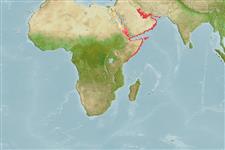Environment: milieu / climate zone / depth range / distribution range
Ecología
marino demersal; rango de profundidad 20 - 50 m (Ref. 28016). Tropical; 30°N - 2°S, 32°E - 62°E
Western Indian Ocean: Persian Gulf (Ref. 3467) to the Red Sea and immigrated via the Suez Canal to the Mediterranean Sea (Ref. 11441).
Tamaño / Peso / Age
Maturity: Lm ? range ? - ? cm
Max length : 25.0 cm TL macho / no sexado; (Ref. 30573)
Short description
Claves de identificación | Morfología | Morfometría
Espinas dorsales (total) : 1; Radios blandos dorsales (total) : 30 - 33; Radios blandos anales: 30 - 33.
Lives in coastal rocky substrate, usually with vegetation. Consumes small invertebrates plucked from rocks (Ref. 52629). One of the earlier Lessepsian immigrants actually well
established in the eastern part of the Mediterranean Sea and it inhabits various substrates and is usually encountered on rocky bottoms with vegetation, sandy and muddy bottoms as well as seagrass meadows (Ref. 104758).
Life cycle and mating behavior
Maturities | Reproducción | Spawnings | Egg(s) | Fecundities | Larva
Hutchins, J.B., 1984. Monacanthidae. In W. Fischer and G. Bianchi (eds.) FAO species identification sheets for fishery purposes. Western Indian Ocean (Fishing Area 51). Vol. 3. FAO, Rome. pag. var. (Ref. 3467)
IUCN Red List Status (Ref. 130435)
Threat to humans
Harmless
Human uses
Pesquerías: escaso valor comercial
Herramientas
Special reports
Download XML
Fuentes de Internet
Estimates based on models
Preferred temperature (Ref.
123201): 23.5 - 29.2, mean 26.1 °C (based on 42 cells).
Phylogenetic diversity index (Ref.
82804): PD
50 = 0.5312 [Uniqueness, from 0.5 = low to 2.0 = high].
Bayesian length-weight: a=0.01738 (0.01425 - 0.02120), b=2.92 (2.86 - 2.98), in cm total length, based on LWR estimates for this species (Ref.
93245).
Nivel trófico (Ref.
69278): 4.6 ±0.09 se; based on food items.
Resiliencia (Ref.
120179): Medio, población duplicada en un tiempo mínimo de 1.4-4.4 años (Preliminary K or Fecundity.).
Fishing Vulnerability (Ref.
59153): Low vulnerability (15 of 100).
Nutrients (Ref.
124155): Calcium = 161 [58, 382] mg/100g; Iron = 1.35 [0.56, 3.19] mg/100g; Protein = 17.1 [14.9, 19.4] %; Omega3 = 0.164 [0.063, 0.399] g/100g; Selenium = 54.6 [24.2, 127.5] μg/100g; VitaminA = 14.8 [4.3, 51.1] μg/100g; Zinc = 1.38 [0.89, 2.24] mg/100g (wet weight);
